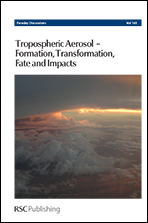Quantitative and time-resolved nanoparticle composition measurements during new particle formation†
Abstract
The chemical composition of 20 nm diameter particles was measured with the Nano Aerosol Mass Spectrometer (NAMS) in a rural/coastal environment during days when new particle formation (NPF) occurred and days when NPF did not occur. NAMS provides a quantitative measure of nanoparticle elemental composition with high time resolution. These measurements show that nanoparticle chemical composition is dynamic on both types of days and that changes in nanoparticle chemical composition do not necessarily correlate with changes in aerosol mass or number concentration. On NPF days, NAMS can distinguish between elements associated with particle formation and early mass growth from those associated with later mass growth. In the early stage of NPF, the particle phase sulphur mole fraction (S) increases simultaneously with the increase in gas phase sulphuric acid. This composition change occurs before the mode diameter has grown into the NAMS-measured size range and is quantitatively described by sulphuric acid condensation. The nitrogen mole fraction (N) also increases during this time period. The N/S mole ratio is approximately 2, indicating that particulate sulphate is fully neutralized. As the mode diameter passes into and through the NAMS-measured size range, N increases at a faster rate than S (N/S mole ratio increases above 2), indicating that a separate, nitrogen-based growth process exists, possibly involving aminium salts, inorganic nitrate and/or organonitrates. Carbonaceous matter is the most abundant component (∼50% by mass) of the growing nanoparticles, but it is the inorganic species that are preferentially enhanced during NPF relative to other times of day. Concurrent measurements of cloud condensation nucleation activity during NPF events suggest that these newly formed particles are hygroscopic. Nanoparticle composition on non-NPF days also shifts toward a more inorganic composition during the daytime, but the chemical species are different from NPF days and the particles are less hygroscopic. Incorporation of S into growing nanoparticles is adequately explained by existing models, but currently no models exist to satisfactorily explain incorporation of nitrogen-containing species or carbonaceous matter.
- This article is part of the themed collection: Tropospheric Aerosol – Formation, Transformation and Impacts

 Please wait while we load your content...
Please wait while we load your content...